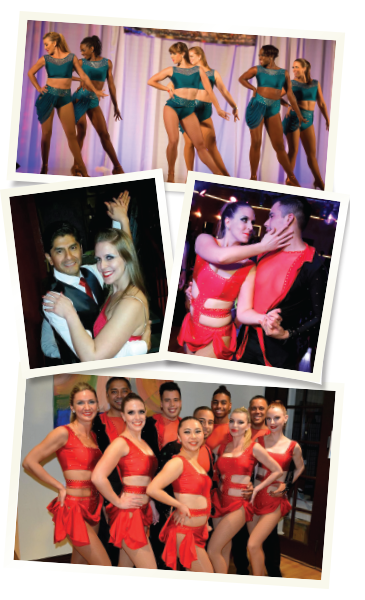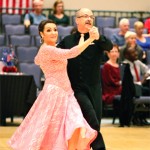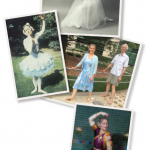Alyssa B. Dufour, PhD, is a salsa dancing junkie. Besides taking weekly dance lessons, she salsa dances three times a week at local clubs or studios and practices routines around the house—while cooking dinner, getting dressed or watching TV. She can’t seem to get enough of the social dance that has boosted her confidence in both her career and personal life.
Dr. Dufour is an assistant scientist and biostatistician at the Institute for Aging Research at Hebrew SeniorLife and instructor in medicine at Harvard Medical School in Boston. She received a doctoral degree in biostatistics in 2013 from Boston University and undergraduate degrees in both math and French—with a minor in computer science—in 2004 from Stonehill College in North Easton, Mass. Because her chosen profession is highly structured, dancing salsa is a way for Dr. Dufour to break loose from medicine’s traditional constraints.
Plié to Line of Dance
Dr. Dufour was introduced to dance when she was 5 years old.
“I started taking ballet and tap lessons like most little girls,” she says. “My mom said I cried every single time I had to go practice. I just didn’t want to go, [so I] quit.”

Top: Salsa y Control’s Gusto performing at the Salsa Festival in Boston in August 2016. Dr. Dufour is in the back row on the far right side. The men are out of view on the right side of the stage. Middle: Dr. Dufour with her partner after a performance of her first routine with Salsa y Control’s Gusto in December 2014 at the Havana Club in Cambridge, Mass. Above: The Alma Latina bachata team after the debut performance of their first routine in Cambridge, Mass. Dr. Dufour is the second woman from the left.
But she returned to ballet years later when she was in graduate school. She took lessons for nearly 18 months, learning the basic steps and positions, such as plié, tondu and sauté. In spring 2013, two girlfriends encouraged her to buy a $20 Groupon for six weeks of salsa dance lessons at a nearby dance studio. Although she thought the idea was “stupid,” she succumbed to their peer pressure and called the studio to register.
“The woman who answered the phone said to just show up,” she recalls. “I asked what if 400 people show up? How do you know there’s going to be enough room? I was very irritated, annoyed at what seemed like a lack of organization.”
As suspected, the studio was packed with wanna-be dancers. However, the directors were personable, excited and clearly loved teaching salsa, making the experience “awesome,” says Dr. Dufour.
She attended lessons every week for another six weeks, learning the basic salsa steps of moving forward and backward. But she never signed up for the next level of lessons, because they interfered with her ballet lessons.
However, her friends continued taking lessons. Later that year, one of them persuaded Dr. Dufour to join Leah’s Chicas, an all-women dance team that rehearsed weekly, practicing one salsa routine that they later performed at salsa nightclubs and other dance venues in the city.
“There were probably 30 women on the team,” she says, explaining that everyone danced in a line to Santa Baby for a Christmas show. “It was meant to be supportive, inclusive and for women to have fun, learn something and then perform it.”
It was so much fun that she stopped taking ballet classes, which were very structured and taught difficult techniques that really couldn’t be performed at any nightclub. Salsa dancing became her new addiction. Since then, she has rehearsed her way up to become an intermediate dancer and joined Gusto, a partner performance team at the same studio—Salsa y Control—in September 2014.
Dancers practiced the choreography for about six months with various partners to learn their unique dance styles and then instructors linked them to the partner they were most in sync with to perform.
“There’s definitely structure to the dance, but you have the ability to make up your own steps and insert your own personality into your dancing,” says Dr. Dufour. “When dancing, the leader or your partner breaks apart from you, which is your time to shine. Maybe you look silly, maybe you don’t. You can do whatever you want, and that’s fun.”
Nearly two years later, however, she was ready to move on to something new. Last July, she began training in a new Latin dance called bachata, which, unlike salsa, she says, moves from side to side and can be more romantic.
Alma Latina, the Mexican-based company that teaches bachata, creates the choreography for each routine, she says, which is taught at the same time at each of its franchise studios throughout the world. This way, she says if dancers travel to other cities or countries, they can visit any franchise studio and perform the same routine together.
Mixing Work with Pleasure
Despite her busy work and dance schedule, Dr. Dufour stills find time to volunteer.
More than a decade ago, her boss and mentor, Marian T. Hannan, DSc, MPH, at Hebrew SeniorLife, who is also past president of the Association of Rheumatology Health Professionals (ARHP), a division of the ACR, and editor of the journal, Arthritis Care & Research, introduced her to the ARHP. Over the past several years, Dr. Dufour has served in various volunteer roles within the association. Currently, she is the organization’s representative to the ACR’s Committee on Education and also a member of the ARHP Executive Committee. After every committee meeting, she encourages members to go dancing with her, even shows them videos and photos on her cell phone of performances by Gusto and Alma Latina dance teams.
“Dancing has definitely made me more outgoing and confident,” she says. “It’s made me feel comfortable with going somewhere by myself, walking into a room full of 200 people, many of whom are strangers, dancing with them and not being embarrassed if I make a mistake.”
She also demonstrates that same level of confidence at work. She says she feels more comfortable developing and sharing her ideas or thoughts on different topics and projects with fellow researchers.
Meanwhile, Dr. Dufour keeps dancing. At 34 years old, she can’t envision ever stopping, no matter her age.
“Just take a lesson,” she says. “You can travel to almost any city, post a message on Facebook asking where you should go dancing on Friday night, and 45 strangers will suggest a place and offer to meet you there. How could you not want to part of something like that?”
Carol Patton is a freelance writer based in Las Vegas.


